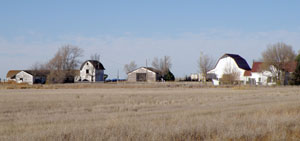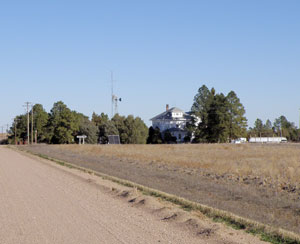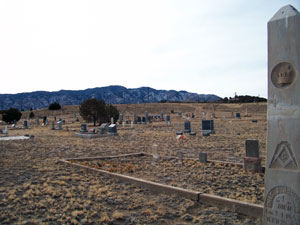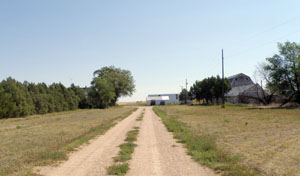Cultural Landscapes Guidance
Although cultural landscapes have been officially recognized as cultural resources since 1983, these often large, usually complex resource types continue to inspire preservationists, archaeologists, historians, landscape architects, land stewards and others to rethink how to best understand, recognize, and preserve them. Through development of The Power of Heritage and Place: A 2020 Action Plan to Advance Preservation in Colorado, History Colorado’s Office of Archaeology and Historic Preservation (OAHP) has made cultural landscapes a priority in its preservation planning efforts. To that end, OAHP has compiled various technical and professional resources below, including information on a two-day workshop on cultural landscapes held in Denver, Colorado in October 2011. Please contact the Preservation Planning Unit for additional information.
Some Definitions
A cultural landscape is defined as “a geographic area, including both cultural and natural resources and the wildlife or domestic animals therein, associated with a historic event, activity, or person or exhibiting other cultural or aesthetic values” (Charles A. Birnbaum, ASLA, Preservation Brief 36: Protecting Cultural Landscapes: Planning, Treatment and Management of Historic Landscapes, 1994).
Cultural Landscapes can be further classified by the following types:
- Historic site A landscape significant for its association with a historic event, activity, or person. Examples include battlefields and president’s house properties. (Birnbaum, Preservation Brief 36)
- Designed historic landscape A landscape that has significance as a design or work of art; was consciously designed and laid out by a master gardener, landscape architect, architect, or horticulturalist to a design principle, or an owner or other amateur using a recognized style or tradition in response or reaction to a recognized style or tradition; has a historical association with a significant person, trend, event, etc. in landscape gardening or landscape architecture; or a significant relationship to the theory or practice of landscape architecture (J. Timothy Keller and Genevieve P. Keller, National Register Bulletin: How to Evaluate and Nominate Designed Historic Landscapes, p. 2)
- Historic vernacular landscape A landscape that evolved through use by the people whose activities or occupancy shaped it. Through social or cultural attitudes of an individual, a family, or a community, the landscape reflects the physical, biological, and cultural character of everyday lives. Function plays a significant role in vernacular landscapes. This can be a farm complex or a district of historic farmsteads along a river valley. Examples include rural historic districts and agricultural landscapes. (The Secretary of the Interior’s Standards for the Treatment of Historic Properties with Guidelines for the Treatment of Cultural Landscapes, 1996)
- Ethnographic landscape A landscape containing a variety of natural and cultural resources that associated people define as heritage resources. Examples are contemporary settlements, sacred religious sites, and massive geological structures. Small plant communities, animals, subsistence and ceremonial grounds are often components. (The Secretary of the Interior’s Standards for the Treatment of Historic Properties with Guidelines for the Treatment of Cultural Landscapes, 1996)
- Rural historic landscape A geographical area that historically has been used by people, or shaped or modified by human activity, occupancy, or intervention, and that possesses a significant concentration, linkage, or continuity of areas of land use, vegetation, buildings and structures, roads and waterways, and natural features (National Register Bulletin: Guidelines for Evaluating and Documenting Rural Historic Landscapes, p. 2)
See Charles A. Birnbaum with Christine Capella Peters, eds., The Secretary of the Interior’s Standards for the Treatment of Historic Properties with Guidelines for the Treatment of Cultural Landscapes (Washington, D.C.: U.S. Department of the Interior, National Park Service, Cultural Resource Stewardship and Partnerships, Heritage Preservation Services, and Historic Landscape Initiative, 1996)
History Colorado Resources
Cultural Landscapes – The Sessions
This workshop (October 4-5, 2011), co-sponsored by the Colorado Office of Archaeology and Historic Preservation (OAHP) and the National Park Service, provided participants an opportunity to examine a range of landscapes and landscape issues, and become familiar with programs and agencies with cultural landscape interests.
Agenda items included the integration of landscape considerations into surveys and National Register nominations; archaeology as a component of cultural landscapes; traditional cultural places; linear resources; designed landscapes; ranches; Hispanic/Latino landscapes; and other topics. Challenges facing stewards of large tracts of land were confronted, including sustainability and the impact of energy initiatives. The agenda was targeted to include topics that appealed to staffs of state, federal, tribal, and local preservation programs and other stewards of cultural landscapes.
Sample National Register Nominations for Colorado Places with Landscape Foci
Please contact our office for copies of nominations that are not available online.
- Evans Homestead, Douglas County
- Von Gohren/Thompson Homestead--Gerry Farm, Weld County
- Provost Homestead – Herring Farm, Larimer County
- Bingham Homestead, Larimer County
- Greenwood Cemetery, Fremont County
- Golden Cemetery, Jefferson County
- Millage Farm, Phillips County
- Evergreen Corner, Phillips County
- Hargreaves Homestead, Phillips County
Colorado Cultural Resources Survey - Historic Cultural Landscapes Form (1404)
Other Resources
The Alliance for Historic Landscape Preservation
The Alliance for Historic Landscape Preservation is an inter-disciplinary professional organization which provides a forum for communication and exchange of information among its members. It is dedicated to the preservation and conservation of historic landscapes in all their variety, from formal gardens and public parks to rural expanses.
American Public Gardens Association
Founded in 1940 as the American Association of Botanical Gardens and Arboreta, the American Public Gardens Association (APGA) adopted a new name in 2006. Over the last six decades, the APGA has emerged as the premiere association for public gardens in North America.
American Society of Landscape Architects
Landscape architects lead the stewardship, planning, and design of our built and natural environments. The Society's mission is to advance landscape architecture through advocacy, communication, education, and fellowship.
Council of Educators in Landscape Architecture
The Council of Educators in Landscape Architecture can trace its beginnings to 1920 and for more than ninety years it has been concerned with the content and quality of professional education in landscape architecture.
The Cultural Landscape Foundation
The Cultural Landscape Foundation is a 501(c)(3) non-profit organization that provides people with the ability to see, understand and value landscape architecture and its practitioners, in the way many people have learned to do with buildings and their designers. Through its Web site, lectures, outreach and publishing, TCLF broadens the support and understanding for cultural landscapes nationwide to help safeguard our priceless heritage for future generations. While TCLF seeks donations to support its efforts, it is not a membership organization.
Foundation for Landscape Studies
The Mission of the Foundation for Landscape Studies is to foster an active understanding of the importance of place in human life. The Foundation for Landscape Studies, a New York not-for-profit corporation, is a tax-exempt public charity under Section 501(c)(3) of the Internal Revenue Code.
International Federation of Landscape Architects Cultural Landscapes Committee
This IFLA CLC website is a vehicle for increased communication, sharing and exchange of expertise for the International Federation of Landscape Architects Cultural Landscapes Committee (IFLA CLC). The overall objective of the website is to foster cultural landscape preservation from within IFLA through building networks and expertise and to encourage greater awareness of and respect for our shared global legacy of cultural landscapes.
International Scientific Committee on Cultural Landscapes (ICOMOS)
In 1992 the World Heritage Convention became the first international legal instrument to recognize and protect cultural landscapes. The Committee at its 16th session adopted guidelines concerning their inclusion in the World Heritage List. The Committee acknowledged that cultural landscapes represent the "combined works of nature and of man" designated in Article 1 of the Convention. They are illustrative of the evolution of human society and settlement over time, under the influence of the physical constraints and/or opportunities presented by their natural environment and of successive social, economic and cultural forces, both external and internal. The term "cultural landscape" embraces a diversity of manifestations of the interaction between humankind and its natural environment.
Library of American Landscape History
The mission of the Library of American Landscape History is to foster understanding of the fine art of landscape architecture and appreciation for North America’s richly varied landscape heritage through LALH books, exhibitions, and online resources.
American Memory: Cultural Landscapes, The Library of Congress
Cultural Landscapes geography is documented in this category by large-scale maps such as individual land surveys, county land ownership maps and atlases, large-scale topographic maps, and thematic maps showing economic activity. These maps show the cultural modification of a physical landscape as settlers established their farmsteads and villages, constructed the connecting transportation systems, and named their surroundings. Some maps show areas occupied by Native Americans, especially after their resettlement by the United States government.
National Association of Olmsted Parks
The National Association for Olmsted Parks (NAOP), established in 1980, is a coalition of design and preservation professionals, historic property and park managers, scholars, municipal officials, citizen activists, and representatives of numerous Olmsted organizations around the United States. Its concern is the legacy of landscape work left by Frederick Law Olmsted Sr. and the firm continued by his sons.
National Park Service
- American Battlefield Protection Program
The American Battlefield Protection Program (ABPP) promotes the preservation of significant historic battlefields associated with wars on American soil. The goals of the program are 1) to protect battlefields and sites associated with armed conflicts that influenced the course of our history, 2) to encourage and assist all Americans in planning for the preservation, management, and interpretation of these sites, and 3) to raise awareness of the importance of preserving battlefields and related sites for future generations. The ABPP focuses primarily on land use, cultural resource and site management planning, and public education. - Cultural Landscapes: Planning
- Historic American Landscape Survey
The Historic American Landscapes Survey (HALS) mission is to record historic landscapes in the United States and its territories through measured drawings and interpretive drawings, written histories, and large-format black and white photographs and color photographs. The National Park Service oversees the daily operation of HALS and formulates policies, sets standards, and drafts procedural guidelines in consultation with the American Society of Landscape Architects (ASLA). The ASLA provides professional guidance and technical advice through their Historic Preservation Professional Practice Network. The Prints & Photographs Division of the Library of Congress preserves the documentation for posterity and makes it available to the general public. - National Center for Preservation Technology and Training: Historic Landscapes
The National Center encourages research and partnerships in the field of historic landscape preservation to improve the technologies available to practitioners as they undertake the complex tasks of documenting, preserving, and interpreting the historic landscapes significant to a wide variety of people and cultures. - National Register Landscape Initiative
The National Park Service has initiated a study of the nomination of landscapes to the National Register of Historic Places. The effort is called the “National Register Landscape Initiative” (NRLI). It involves a number of stakeholders in the National Register program, especially those with an interest or expertise in landscape issues. For several months they will be meeting by webinar to identify and discuss the issues that hinder or foster landscape nominations. - National Register of Historic Places
The National Register of Historic Places is the official list of the Nation's historic places worthy of preservation. Authorized by the National Historic Preservation Act of 1966, the National Park Service's National Register of Historic Places is part of a national program to coordinate and support public and private efforts to identify, evaluate, and protect America's historic and archeological resources. Access National Register Bulletins - Olmsted Center for Landscape Preservation
The Olmsted Center for Landscape Preservation strengthens the capacity of parks and historic properties to manage cultural landscapes as part of our national heritage. Working in partnership with national parks, universities, government agencies, and non-profit organizations, the Olmsted Center provides a full range of technical assistance in cultural landscape research, planning, stewardship, and education. Founded at the Frederick Law Olmsted National Historic Site, the Olmsted Center perpetuates the traditions of the Olmsted Offices and Frederick Law Olmsted, Sr.'s lifelong commitment to people, parks, and public spaces. - Park Cultural Landscapes
- Technical Preservation Services: Cultural Landscapes
- Charles A. Birnbaum, ASLA, Preservation Brief 36: Protecting Cultural Landscapes: Planning, Treatment and Management of Historic Landscapes (Sep 1994)
- Cultural Landscapes Currents [case studies]
- The Secretary of the Interior’s Standards for the Treatment of Historic Properties and Guidelines for the Treatment of Cultural Landscapes
Select State Historic Preservation Offices
- Georgia’s Historic Landscape Initiative
- Massachusetts Energy and Environmental Affairs: Historic Landscape Preservation Initiative
- Minnesota Historical Society: Inventorying, Managing and Preserving Agricultural Historic Landscapes in Minnesota
- Pennsylvania Historic Preservation Office: Landscape Conservation
- Texas Historical Commission: Cultural Landscapes
- Washington State Department of Archaeology & Historic Preservation: Cultural Landscape Preservation
- Wyoming State Historic Preservation Office: Historic Preservation Training Presentations
Smithsonian Gardens: Archives of American Gardens
The mission of the Archives of American Gardens: To collect and make available for research use unique, high quality images of and documentation relating to a wide variety of cultivated gardens throughout the United States that are not documented elsewhere since historic, designed and cultural landscapes are subject to change, loss and destruction. In this way, AAG strives to preserve and highlight a meaningful compendium of significant aspects of gardening in the United States for the benefit of researchers and the public today and in the future.




